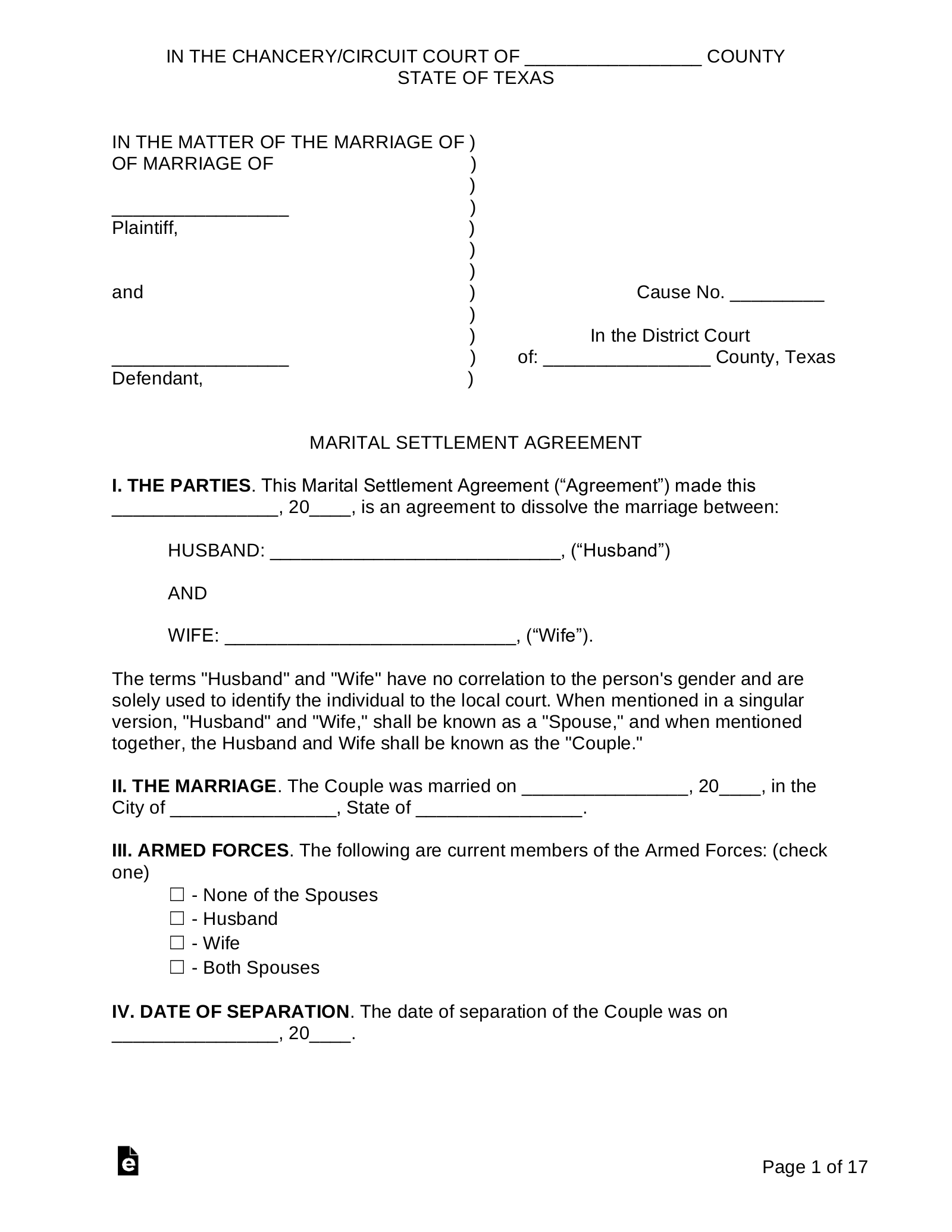Updated August 29, 2023
A Texas marital settlement agreement is a document completed by a married couple and used to divide assets, property, child support/custody responsibilities, and liability following a divorce. The spouses can use the form to organize their affairs and reach a mutually agreeable decision that relays to the judge that they wish to divide assets and responsibilities outside of court. It is often wise to have a third-party mediator present during the negotiation along with each spouse’s respective attorney in order to ensure a fair settlement. Once signed by both parties, the agreement becomes legally binding.
Table of Contents |
Divorce Laws
Statutes – TX Fam Code – Subtitle C. Dissolution of Marriage
Alimony (TX Fam Code – Chapter 8) – Alimony, or spousal maintenance (as it is referred to in Texas), are payments given from one spouse to the other following a divorce. The factors that the court will take into consideration when determining the amount, duration, and recipient are as follows:
- The spouses’ individual ability to provide for themselves and their children;
- The education and skills of each spouse as well as the time and feasibility of obtaining sufficient education;
- Duration of the marriage;
- Age, past employment, earning ability, and mental/physical condition of the recipient;
- Irresponsible spending and destruction of community property by either spouse;
- Contribution to the education and earning power of one spouse to the other;
- Property brought to the marriage by either spouse;
- Contributions as a homemaker;
- Adultery and other cruel treatment; and
- Any family violence.
Alimony Calculator – Calculators.law
Child Support (TX Fam Code – § 154.001) – The amount of child support a spouse will be required to pay is based on the monthly net resources of the obliger (payer). Texas Child Support Guidelines can be located in § 154.125 – Application of Guidelines to Net Resources.
Child Support Calculator – oag.texas.gov
Division of Property (TX Fam Code – § 7.001) – When determining the division of property in Texas, the court will distribute assets and debt as they see “just and right.” Texas is one of nine (9) states that recognizes Community Property Law, which states that all property earned during the marriage is owned equally by both parties unless proven as separate.
Grounds for Divorce (TX Fam Code § 6.001 – § 6.007) – The following are considered grounds for divorce in Texas:
- Insupportability
- Cruelty
- Adultery
- Conviction of Felony
- Abandonment
- Living Apart
- Confinement in Mental Hospital
Interim Support (TX Fam Code §6.502) – While a suit for the dissolution of marriage is pending, the court may order one (1) party to make payments in support of the other spouse.
Residency (TX Fam Code § 6.301) – A suit may not be filed unless either the petitioner or the respondent has resided in the county in which the suit is filed for at least ninety (90) days, and they have resided in the state for at least six (6) months.
Divorce Forms
- Where to File – District Court
- Filing Fee – $150- $300 (depending on county)
- How Long Does it Take? – At least sixty (60) days (source: texaslawhelp.org)
Uncontested Divorce Without Children – Instructions and Filing Packet
- Civil Case Information Sheet (also available at courthouse)
- Affidavit of Indigency/Affidavit of Inability to Afford Payment of Court Costs
- Original Petition for Divorce
- Waiver of Service
- Return of Service Form (used by process server or court clerk)
- Respondent Original Answer
- Final Decree of Divorce
- Certificate of Last Known Address
- Notice of Change of Address
- Affidavit of Military Status
- Order Restoring Name Used Before Marriage
- Sample Testimony Divorce without Children
Uncontested Divorce With Children:
- Civil Case Information Sheet
- Original Petition for Divorce
- Affidavit of Inability to Afford Payment of Court Costs
- Out-of-State Party Declaration
- Waiver of Service
- Return of Service Form (used by process server or court clerk)
- Respondent Original Answer
- Final Decree of Divorce
- Certificate of Last Known Address
- Notice of Change of Address
- Standard Possession Order
- Income Withholding Order for Support
- Information on Suit Affecting the Family Relationship
- Order Restoring Name Used Before Marriage
- Sample Testimony Divorce with Children
How to File for Divorce in Texas (8 steps)
- Fill out Petition for Divorce
- File Petition
- Notify Respondent of Divorce Filing
- Marital Settlement Agreement
- Fill out Final Divorce Decree and Other Court Forms
- Prepare Testimony
- Finalize Divorce Case in Court
- Name Change
Note: The below instructions are for uncontested divorces wherein both parties agree on all terms related to the divorce. They do not cover contested divorces.
1. Fill out Petition for Divorce

The first thing a couple has to do after deciding to file for divorce is to ascertain if they are eligible to do so. In order to file in the county in which they reside, at least one of the parties has to have lived there for a minimum of ninety (90) days and have resided in-state for at least six (6) months (TX Fam Code § 6.301). Once they’re certain of the district court where they’ll be filing, they can start filling out the paperwork.
The first form to complete and sign is the Original Petition for Divorce (with children|without children). The spouse completing and filing the Petition for Divorce is called the “petitioner” and the other spouse the “respondent.” If the petitioner anticipates that they cannot afford the filing fees, they should also complete the Affidavit of Inability to Afford Payment of Court Costs (can also use the Affidavit of Indigency found in the filing packet). Finally, it may be necessary to fill out a Civil Case Information Sheet. While the Supreme Court repealed the rule requiring the document, it is recommended that petitioners filing in-person complete one to be safe.
2. File Petition

Two (2) copies should be made of the petition and the affidavit (if applicable). The petitioner can then file the documents in person at the local District Court clerk’s office and pay the filing fee (if the petitioner is not asking the clerk to waive court costs). If preferable, petitioners can file their forms online using the E-File Texas service. The clerk will stamp the copies of the forms with a date and time, return them to the petitioner, and keep the originals. If the petitioner wishes to notify the respondent via Official Service of Process (more below), they will need to communicate this to the clerk when filing the petition.
3. Notify Respondent of Divorce Filing

The respondent (another spouse) must be delivered a copy of the stamped petition to notify them that a divorce action has been started. This process can be handled in the following ways:
- The petitioner can mail or personally deliver the petition to the respondent with a blank Waiver of Service form (can also use the form found in the Filing Packet). The respondent will need to complete and sign the waiver before a notary public to communicate that they’d like to waive the official service of process. The Waiver of Service can then be filed with the court. This method of delivery should be used if the couple agrees to all terms of the divorce. If the respondent contests the divorce, they can file a Respondent Original Answer (without children|with children) instead of a waiver.*
- The petitioner can opt to notify the respondent via Official Service of Process by requesting this option at the courthouse and paying the applicable fee. In this case, the sheriff, a constable, or a process server will serve the petition on the respondent, or the clerk will send it by certified mail with a request for receipt attached. If law enforcement or a process server was hired, they will complete a Return of Service form and file it at the courthouse providing proof of service. If sent by certified mail, the respondent will have to sign the return receipt and file it with the court or return it to the petitioner to do so themselves.
- If the whereabouts of the respondent is unknown, the petitioner can post the paperwork at the courthouse or publish the legal notice in a local newspaper.
*An agreed divorce can still be filed if an answer is used instead of a waiver so long as the respondent and petitioner eventually come to an agreement and sign the Final Divorce Decree (below).
4. Marital Settlement Agreement

A Marital Settlement Agreement can be drafted really at any point in the divorce proceedings. It enables the parties to negotiate terms like child support, child custody, and the division of community property, and to sign off on them before entering them into the Final Divorce Decree. This step is optional but can be useful by listing any items or conditions not provided in the Final Divorce Decree document.
5. Fill out Final Divorce Decree and Other Court Forms

The petitioner will need to complete and sign the Final Decree of Divorce document (with children|without children) before going to court. It is not uncommon for both parties to complete the form together as it defines the terms of the divorce. In an uncontested divorce, the respondent is required to sign the Final Decree of Divorce if they’ve signed an Original Answer or Waiver of Service. If the respondent has not filed an Original Answer or Waiver of Service, the petitioner will need to also complete a Certificate of Last Known Address form and a Military Status Affidavit (both found in the Filing Packet) and make a copy of each in preparation for finishing the case by default.
If the spouses have children together, the petitioner will also have to complete and sign a Standard Possession Order, the Information on Suit Affecting the Family Relationship form, and an Income Withholding Order for Support (if child support will be ordered). If the Standard Possession Order doesn’t work with the couple’s particular circumstances, an attorney can be hired to create a more suitable alternative.
6. Prepare Testimony

In preparation for court, the petitioner should complete a Sample Testimony (with children|without children) to read before the judge. Alternatively, if the above-linked testimony does not apply to the particular scenario, an attorney can draft one that does. It is possible that the judge will instead ask questions instead of a written testimony; however, it is recommended that a prepared statement be drafted nonetheless.
7. Finalize Divorce Case in Court

After at least sixty (60) days have passed since the original petition was filed, the petitioner can contact the court clerk to find out when they hear uncontested cases. The petitioner will need to go to the courthouse on that day with the following documents in hand:
- A stamped copy of the Original Petition for Divorce
- Final Decree of Divorce
- Waiver of Service (if applicable and not already filed by the other spouse)
- Respondent Original Answer (if applicable)
- Certificate of Last Known Address (if the respondent has not filed waiver/answer or signed decree)
- Military Status Affidavit (if the respondent has not filed waiver/answer or signed decree)
- Income Withholding Order for Support (if child support will be ordered)
- Possession Order (if spouses have children together)
- Information on Suit Affecting the Family Relationship (if spouses have children together)
- Sample Testimony
Once at the courthouse, they will need to approach the court clerk and file the Waiver of Service or Original Answer if it hasn’t already been filed. If neither has been completed or signed by the other spouse, the petitioner will need to file the Military Status Affidavit and the Certificate of Last Known Address with the clerk who will in turn stamp and return a copy. All forms can then be taken to the courtroom and filed with the clerk there.
When the case is called, the judge will hear the petitioner’s testimony or ask questions to learn about the case. If everything is in order, they will sign the Final Decree of Divorce. The signed decree and the Information on Suit Affecting the Family Relationship (if applicable) must be filed with the clerk following the hearing. This filing finalizes the divorce process.
8. Name Change

If either party wishes to change their name back to what it was before marriage, they will need to specify this in the Original Petition for Divorce or the Waiver of Service, and the Final Decree of Divorce. Once changed, the signed decree can be used to update accounts, licenses, and identification.


